 Isn’t that AWESOME? Last week, Animated Views was kindly invited by Walt Disney Studios Home Entertainment to take part in a roundtable discussion with the creators of Rhino themselves: Bolt‘s story supervisor Nathan Greno, and Rhino’s very voice artist Mark Walton! Can you imagine? It’s even beyond awesome… It’s BE-AWESOME!
Isn’t that AWESOME? Last week, Animated Views was kindly invited by Walt Disney Studios Home Entertainment to take part in a roundtable discussion with the creators of Rhino themselves: Bolt‘s story supervisor Nathan Greno, and Rhino’s very voice artist Mark Walton! Can you imagine? It’s even beyond awesome… It’s BE-AWESOME!
So, without any further ado…. Let it begin! LET IT BEGIN!
And let’s begin with Nathan Greno! Bolt‘s story supervisor arrived at Walt Disney Animation Studios in 1996, trading the four seasons of the Midwest for the sunny climate of the Pacific Coast. He began his career in traditional animation working as a clean-up artist on the worldwide hit Mulan. Since then, Nathan has served a variety of capacities on such films as Brother Bear (story artist), Meet the Robinsons (screenplay, story artist, voice actor) and, most recently, as story supervisor on Bolt.
In that role, Nathan oversaw the story of the film, the storyboarding of all sequences, and managed the story crew and their assignments. Now, he’s just finished directing his first short, Super Rhino, presented as a bonus feature on the Bolt DVD and is currently co-directing the Studio’s upcoming feature film, Rapunzel, along side Byron Howard (co-director of Bolt).
Born and raised in Kenosha, Wisconsin, Nathan attended the Columbus College of Art and Design in Columbus, Ohio prior to gaining employment with Disney Animation. He resides in Glendale, CA, with his girlfriend Meredith and two pet cats, named Cheese and….Rhino!
Roundtable Interviewer: How did you jump into the animated world? How did you started in this job?
Nathan Greno: As a kid I was always drawing my own cartoons. I grew up in a small town in Wisconsin and the idea of working for Disney Animation was a big dream to have. I went to art school in Columbus, Ohio — spending every free second working on my portfolio for Disney. In 1996 I started with the mouse as a “clean-up” artist on Mulan. A year later I was working on a portfolio to get into the Disney Story Department. You have to do a “test” if you want to jump departments at Disney. Needless to say, things worked out!

RI: What was your favorite animated movie when you were a kid?
NG: Dumbo is my favorite animated film of all time. It has the perfect balance of everything. Humor, emotion — its really a fun, entertaining, heartbreaking film. I love it.
RI: How do you create a story like the one of Bolt?
NG: Animation story boarding works differently than live action story boarding. The story crew (along with a writer) really does shape and create the film — the world and its characters. We meet almost every day and brainstorm the plot of the film. It’s a highly collaborative process — and we continue to improve the story until we literally run out of time.

RI: What is your favorite Bolt scene, and why?
NG: It’s hard to pick a favorite! I love the “fake” TV ending — it’s really goofy and unexpected. It’s also really heartbreaking to watch Bolt return to the set only to find Penny has “replaced” him. I’m really proud of what we did with that scene.
RI: How important do you think “sidekick-characters”, such as Rhino, are in a feature film?
NG: Sidekicks should only be used when they support your story/plot. I don’t think you NEED to have sidekicks in a film. Rhino definitely added humor to Bolt, but he also helped to drive the film forward. He’s a simple, single-minded character — but he’s also one of the smartest characters in the film. His crazy rants to both Bolt and Mittens turn out to be surprisingly enlightening.
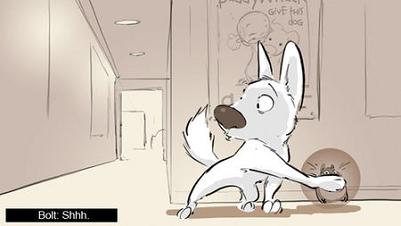
RI: Are you more a dog person or a cat person? …Or a hamster person?
NG: I have two cats Cheese and Rhino (yep, that’s where the name came from!) — but I do love dogs too. At some point (when my schedule cools off) I want to adopt a puppy….not sure how the cats are going to handle that!
RI: Do you usually try to put something or someone familiar in the movies you work on?
NG: You almost can’t help it! We really throw ourselves into our work and the details from your life show up from time to time in the finished film. Our personal experiences really help to bring shape to the movies we make at Disney.
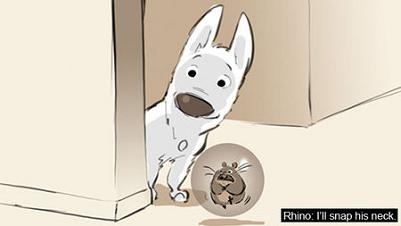
RI: When did you get the idea to do the Super Rhino short for the DVD? How long did it take to make it?
NG: When I was finishing up as story supervisor on Bolt, John Lasseter asked for short pitches for the DVD. I wanted to do something different and unexpected — Rhino with Bolt’s powers fit the bill. So,I pitched the idea of Rhino getting Bolt’s powers. John was onboard and asked me to start developing the idea. The schedule was very tight, I believe we finished the entire short in 3-4 months (the crew was still finishing Bolt at the time!).
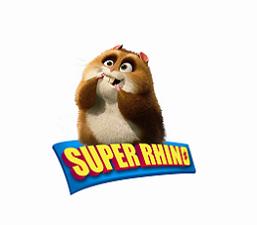
RI: What was it like working with John Lasseter?
NG: John is an amazing mentor — the guy is a genius. I meet with him once a week and I learn something new every week. The great thing is, John makes the movies WITH us — it’s the best way to work.
RI: Since the short was produced so quickly, had Rhino been popular with test audiences beforehand?
NG: Rhino was extremely popular within the studio — and a favorite character among the story dept. It seemed fitting to build a short around him.

RI: Why do you think it’s so often the supporting characters from these animated films that people want to see star in their own shorts? (Mater, Jack Jack, etc.)
NG: The supporting characters typically carry less story/plot weight — so you can be more broad and pushed with them. Supporting characters also take up less of the film’s screen time. A short is a great opportunity for supporting characters to shine. Rhino is so pushed and single minded — the idea of him staring in his own film was really entertaining to me.
RI: Rhino is the most charismatic character of Bolt. What challenges found the animators working with such a small and chubby character and that in addition moves in a ball?
NG: Working on the short, I found Rhino’s shape (a round ball with tiny arms and legs) presented a number of limitations — but the limitations are what makes him so incredibly funny. In the short, we have him doing aerobics in his ball and it’s funny because of his shape. Sometimes the limitations work in your favor.

RI: What did Miley Cyrus think of the Hannah Montana parody?
NG: Miley was incredibly easy to work with — she’s very enthusiastic and professional. I haven’t heard her reaction to the finished short — but I’m sure she’ll laugh. She has a great sense of humor.
RI: CGI movies often still have to solve really hard technical problems to make a movie. Did you have to modify or adapt a story point because the animators said, “We don’t know how to do that” or “We can’t do that in time”?
NG: The studio as a whole is always trying to make the best movies we can. John Lasseter expects the highest level of entertainment in our films and we are more than happy to deliver. It’s amazing what you can accomplish when you think outside of the box.

RI: What do you think of CG animation regarding 2D animation?
NG: There are a number of 2D projects in development at Disney Animation. 3D is one (of many) tools used to produce great animated films and shorts.
RI: Are there any future plans for the awesome Rhino?
NG: You never know! While we were working on Bolt we had no idea there was going to be a Rhino short! Time will tell.
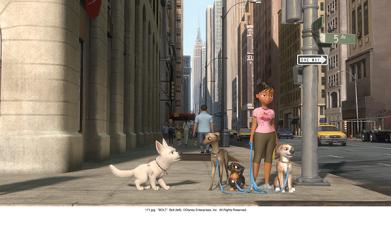
RI: What can you tell us about the difference between working on the film Bolt and the short Super Rhino?
NG: Developing a full length feature is much longer process than developing a short. With features you’re typically dealing with more characters, plot, emotion, story arc, etc. A short is the same only much…shorter! My biggest challenge on Super Rhino was learning to work with other departments outside of the story dept. I honestly learned something new every day. I went from working in my story boarding bubble to working with every department in the building. It was an amazing eye-opening experience for me. The advantage with the Super Rhino short was having the advantage of using pre-existing characters — the fun came from the unexpected story twists I put them through. When you develop an entire feature length film from scratch (as we did on Bolt) the challenge is developing an entire feature length film from scratch — the world and all of it’s characters need to be created. There is no story/plot — all you have is a blank sheet of paper.
RI: Do you consider Super Rhino as a prelude to Rapunzel, or the icing on the cake of Bolt?
NG: Super Rhino was my training to direct. The shorts program at Disney is fantastic because it provides a chance for future directors to cut their teeth, to direct on a much smaller level before jumping into a full length feature. The program allows John Lasseter to get to know you — it’s a fantastic system. Taking on a feature is a huge responsibility — directing a short is a great way to learn about other departments and the people who work in them. The knowledge I’ve gained has been incredibly helpful on Rapunzel and I feel prepared to handle my directing duties on the movie because of my experience on Super Rhino.
RI: How much can you speak about Rapunzel without putting our lives at risk?
NG: I couldn’t be happier with the direction Rapunzel is headed. It’s a very smart, funny comedy. Stay tuned!
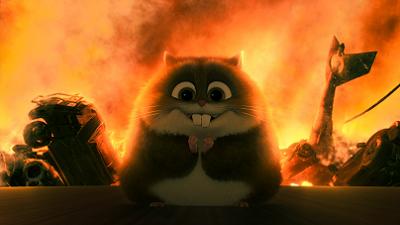
 And the fun continues with Rhino himself…well, his voice artist, Mark Walton!
And the fun continues with Rhino himself…well, his voice artist, Mark Walton!
Mark was born and raised in Salt Lake City, Utah. He attended East High School and Utah State University in Logan, Utah. He had always wanted to be an artist of some kind — cartoonist, animator, Muppet designer, feature film special effects, children’s book illustrator. Instead of starting work at a video gaming company (his intended career trajectory), he was accepted into the Disney family on the first day of his intended employment.
Mark started working at Walt Disney Animation Studios in the Florida division in September of 1995. Following an internship and a mall tour, he became a story apprentice on Tarzan. In addition to providing the voice of Rhino — a hamster and super-fan of the television character of Bolt — Mark is currently serving as the visual development artist on the upcoming feature King of the Elves.
Now, as such, he explores the look and the personalities of the different characters of the film, as well as their relationships with each other, their backgrounds and their potential actions and dialogue in the film. He also investigates the environments that the story takes place in (their look and feel, particular qualities, important elements and potential additional inhabitants).
Roundtable Interviewer: You took part in the story development of many Disney films like Tarzan, Home on the Range, Chicken Little, The Little Matchgirl and Meet the Robinsons. Is it more difficult to create a story from scratch or to transform an earlier treatment?
Mark Walton: Nathan probably has his own take, but I think that both are easy and hard in different ways. When you’re adapting a book or a script, the good thing is you already have a structure to build upon – a lot of the questions about how the characters relate to each other, and what the story is really about, have hopefully already been answered. There’s almost always still a lot of details that need to be resolved or changed to make the story work as a movie, but there’s not as much to figure out from scratch – and, of course, there’s the hope that if people liked the book or whatever, that we know the story works in some way, and that there’s a built-in audience. Of course, the problem is, if there’s characters or story elements that DON’T work at all, it’s hard to know how much you can get away with changing without violating the spirit of the original, or alienating fans of the original. When you have to make everything up from scratch, it’s obviously a lot of work, and you have to prove the story will work, and that people will show up to something new, but you don’t have any of the baggage of a previous story or fans to please – you can do whatever you want.
RI: What are your favorite animated stories?
MW: Ooh – that’s a long answer. All the classic Disney movies from Snow White forward – my favorite stories create characters that you really enjoy spending time with and care what happens to them. I like big epics like Happy Feet as well as small character stories like Dumbo and The Iron Giant. I also love it when they create a world that I believe in and want to explore, like in Finding Nemo and The Nightmare Before Christmas. I could say a lot more, but I wouldn’t answer anyone else’s questions! Good question, though!
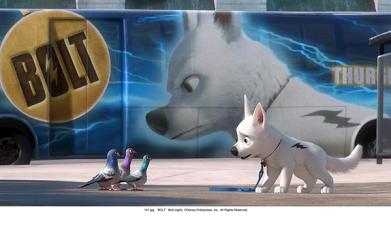
RI: What was your favorite animated movie when you were a kid?
MW: Hard question, lots of contenders (mostly Disney classics, of course!) – I’d say something between Fantasia (animation! Demons! Dinosaurs! All together!), The Rescuers, and Secret of Nimh (of course, it was limited to what was re-released in theaters or available on tape, which wasn’t much when I was a kid! I’m Ollllld.)
RI: Who were some of your animation influences?
MW: Well, all of the Disney classics are films I’ve watched over and over – Snow White, Pinocchio, Fantasia, 101 Dalmatians (Milt Kahl and Marc Davis are geniuses!), and so many of the Pixar movies – Toy Story, Finding Nemo, The Incredibles, Nightmare Before Christmas…heh, maybe I should email you a complete list later – this could take all morning!
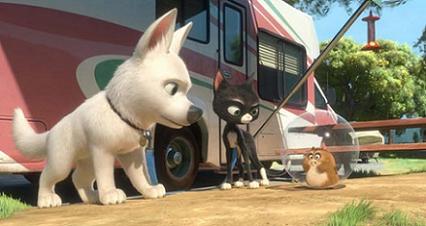
RI: Disney animation movies have always dealt with the animal world. What is its power?
MW: Well, if I understand your question correctly, I think that people in all cultures have enjoyed watching stories about animals – superimposing our weaknesses and strengths, dealing with some of the same problems and issues in the human world. And animals are generally just more fun and appealing to watch! I think that even media-savvy kids today enjoy seeing entertaining stories about animals – I think the idea of being able to communicate with animals, or knowing what they’re thinking, is something that kids enjoy imagining.
RI: How do you feel about the overall reception of Bolt?
MW: The reception was really gratifying – lots and lots of positive reviews (an unusually high “rotten tomatoes” rating), the Academy Award nomination, an Annie nomination for me – it was awesome. Hopefully even more people will watch the DVD.
RI: Rhino is not the first character you voice. Can you tell me your other ones?
MW: I did do Barry and Bob, a couple of longhorn steers that hit on the cows in Home on the Range, as well as some honking and freaking out for Goosey Loosey in Chicken Little. Barry and Bob were fun because I got to come up with those characters and write most of their dialogue myself (maybe that’s why they let me do the voice). Working on an animated movie is so much fun – you only have to pretend to do amazing things, and then the world’s best animators make your performance better and better, every time you see it, and you know that if the movie is good, people all over the world are going to see and hear your character for a long time.

RI: How did you come up with the voice for Rhino? Was it based on anyone?
MW: I’m pretty much just doing my voice, my personality. I mean, I hope I have a slightly stronger grip on reality than Rhino does, but we’re both pretty enthusiastic about the people and things we’re interested in, and un-self-conscious about how we come across to others. I tried doing what I thought was a hamster voice when I first auditioned, but the directors (who know me) told me to just be myself as much as possible. I do have other friends who are really into Star Trek, Star Wars, comic books, Disney, animation, etc, and I suppose I thought about them a little when Rhino was being really obsessive, but it’s mostly me.
RI: In what way was working on Rhino different from voicing Goosey Loosey in Chicken Little (if at all)? Were there any specific, new challenges?
MW: Well, Goosey Loosey was fun, but all I was doing was basically doing crazy goose-like sounds – basically she’s freaking out and going into some kind of berserker rage whenever I do her voice. Rhino actually has to act, and has a lot more range. Luckily, I got to do my normal speaking voice, so it was easier to focus on getting the acting right. Both were fun, but Rhino was a lot more involved. I had to be a lot more concerned with being clear and intelligible with Rhino, too – Goosey was covered up with a lot of music and loud sound effects, so it almost didn’t matter what I did.
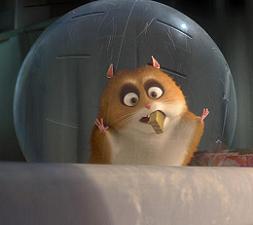 RI: As you said it, Rhino is a lot like you. But was there a portion of the movie that was unusually hard for you to do, or where you had the hardest time doing it “in character”?
RI: As you said it, Rhino is a lot like you. But was there a portion of the movie that was unusually hard for you to do, or where you had the hardest time doing it “in character”?
MW: Actually, most of the time, it was pretty easy – the directors pretty much just wanted me to be myself as much as possible (well, if I happened to be a hamster). The hardest part for me, I think, was just enunciating, speaking clearly and not too slowly – I sound pretty mumbly and unintelligible in normal life, but I tried to step up my game for Rhino, and having the editors choose the best takes of every line reading (sometimes 60 for a single line) helped too!
RI: Is voice acting a difficult kind of acting to get right? Are a lot of takes necessary?
MW: The lucky thing for me, with Rhino, was that I didn’t have to do a voice or an accent, or a character that was totally different from me. I know that some actors really miss working with the other actors in the room, but the nice thing for me is that you don’t have to worry about costumes or makeup or hitting your marks or memorizing your lines – you get to cut to the fun part with a minimum of fuss. I did have to do a lot of takes – there were a couple of the lines in the big inspiring speeches that I did 60 or more takes for, and then they still brought me back a few more times, because they really wanted to get the performance exactly right. But that’s the great thing – they’ll keep trying until it’s as good as it can be. It’s tiring sometimes, but then everyone’s happy with the results.
RI: Did you work with Nathan Greno on building the character of Rhino (from a story artist to another story artist)?
MW: I think that Nathan, the directors, and the story crew pretty much had Rhino figured out before I ever started doing the voice. I think that they put more of Rhino into the movie as the story evolved, because people liked him – giving him these little speeches to inspire Mittens and Bolt, for example – but I think that was just because Rhino was a really funny idea for a character, and really well – written. I just showed up for the recording and had fun.
RI: What did you bring to the character of Rhino? How did you manage to make him that crazy (in the greatest sense)?
MW: Well, I just tried to imagine how I would feel if the character of my favorite book or movie showed up, in the flesh, at my door to take me on an adventure – how would I feel? How would I act? (Ecstatic and slightly crazy!) Luckily, the writing for Rhino was so good, I felt like it was easy to know how to act, and the directors helped coach me a lot. I guess there’s something about my voice and my laugh that some people liked, but so many people – the writers, animators, modelers, etc. did so much to bring Rhino to life, I feel like I was just the cherry on top.
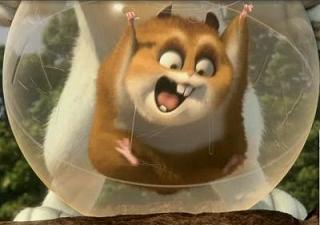
RI: Did they change anything in the story because of your awesome performance?
MW: I don’t know if they changed or adjusted anything for me – I pretty much just read the lines that were written, they were so funny! I think the character became more and more popular in screenings, so they found ways to give him more to say and do in the movie – I’d like to think I brought a generous helping of “awesome” to the character – or at least a funny voice and laugh.
RI: You originally did the scratch track for Rhino. Was any of that track retained, or was it all rerecorded?
MW: A lot of the scratch track was kept untouched – they were really careful when they recorded it, and a lot of the lines (like where he first meets Bolt and Mittens) stayed the same. A lot of the lines changed, of course, and every once in a while, they’d come back to me and say, this line is a little unclear, or could I say the line faster, but most of the time, they had me do lots of takes the first time through, and got the take they wanted.
RI: Was there chemistry with the other actors? Or did you always work separately on the voice acting?
MW: Unfortunately, I never got to work with the other actors, but I got to spend a little time talking with some of them afterwards, like Susie Essman and Malcolm McDowell, who are both really cool. I’m friends with the woman who did the security guard’s voice (Esther) in the dog pound – she’s really cool, and is a school teacher! The good thing about recording everyone separately is it gives the directors more control – they can change one character’s lines in a scene without having to re-record everybody, and the story changes a lot before the movie comes out.
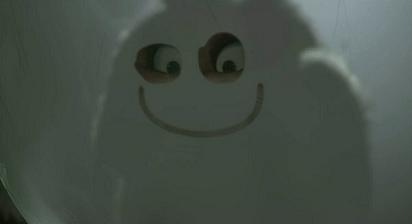
RI: In a lot of countries the voices are dubbed. Do you think that dubbing is still necessary (subtitles are not enough)? And how important it’s for you the choice of the voices?
MW: Well, I guess it’s necessary for the people who don’t want to read subtitles! And I know many people in the US and abroad don’t, so it’s great that they can watch an accessible version of great movies. I really like to try to watch films in the original language, because I want to hear the original performance as it was directed, and I think there’s a lot of people that feel that way. It’s hard when people want to see the original language version but the only one that plays is the dubbed version, but there’s always the DVD at least. Picking the right voice is really important, and the guys who do the dubbing have to be amazing, to match the lip-sync, and say things that have often been changed in intent (not just the language) to make more sense to the local culture, and still ACT – and I have to say, the people that Disney International picks usually do a really good job.
RI: What did you like the most about Rhino?
MW: I really like how Rhino is comfortable in his own skin – he’s enthusiastic and crazy, and he worships Bolt, and he doesn’t care if anyone else approves or understands or likes his crazy laugh – if he was an evil jerk, that could be a problem, but I think his love of Bolt and his enthusiasm are contagious. Plus, he doesn’t ever seem to let his physical limitations get in the way of doing what he needs to do – for a hamster in a ball, he does some pretty amazing things!
RI: What was it like working with John Lasseter?
MW: Well, I wasn’t really working directly with John doing the recording, but it was really encouraging to hear that he liked Rhino and liked what I was doing! He is a real inspiration to the entire studio, being a successful filmmaker himself.
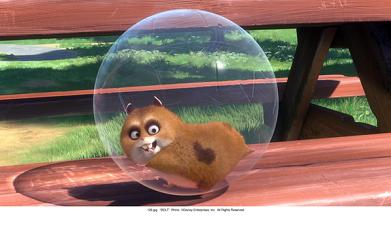
RI: What is that blobby thing on Rhino’s side? Is it supposed to represent something like Bolt’s lightning bolt, or is it just a different colored patch of fur?
MW: I think it’s just a patch of darker fur, but Rhino, delusional as ever, equates it to Bolt’s lightning bolt mark, linking him (in his mind) even more closely to his hero.
RI: What is your favorite Bolt scene?
MW: For me, I really like the escape from the animal shelter – the writing, the designs of the guards, the animation, the voice performances, all came together in top form (plus, I got to sing!) I also love the bit where Bolt thinks that Penny has “moved on” and he drops the carrot – it chokes me up just writing about it!
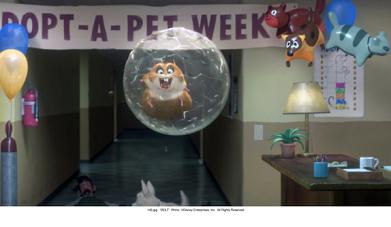
RI: What scenes from Bolt do you think will look best on Blu-ray?
MW: The scenes that will look best in Blu-ray will have Rhino, in all his glory, on the screen…! Actually, I haven’t seen the Blu-ray transfer yet, but I bet any scene with a lot of detail (there are some beautiful backgrounds in the movie!) will really sing in Blu-ray. I just got a Blu-Ray player, and I’m excited to see all the bonus features, like the game I did some lines for. I’m glad it looks good. Seeing the movie in 3D on a big screen is awesome, of course, but a good home theater is hard to beat (especially since you don’t have to see it with annoying people who talk or text during the whole thing – well, unless your family is all jerks!)
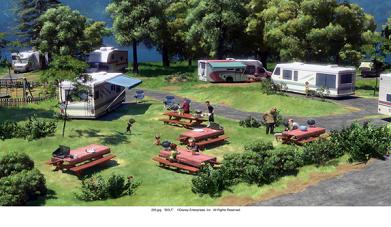
RI: Are you guys from Disney already thinking in 3D all the time?
MW: Yes, I think in color too! Seriously, I do think that we imagine what stuff we can do in 3D sometimes, but great storytelling is great storytelling in 2D and 3D, and not everyone can watch the movie in 3D (yet, anyway), so we have to make sure the movie and the story work either way.
RI: You mentioned the game present on the DVD. Is there a lot of overlap between video game animation and (animated) feature animation?
MW: Well, more and more people have worked for animated features as well as doing work for video games – animators, visual development artists, modelers, matte painters, etc. Obviously there are differences – video games have to be designed to be explored randomly, and the characters have to be programmed to do a lot of different possible things, whereas in a movie, it’s just from one point of view, and you’re coming up with enough stuff to fill an hour or two instead of 10 or 20 hours. And video game engines can’y handle the kind of complexity and realism you can’t put into a movie – yet. But games are getting better and better – I imagine a day where you won’t be able to tell a game from a movie, with great A.I. animation and photoreal, interactive environments, etc.
RI: Do you feel videogames and feature (animated or otherwise) movies are starting to resemble each other more and more? Is this a good development (and, if yes, for which medium in particular)?
MW: I think it’s really cool that videogames are getting more and more sophisticated and believable, and that people who worked on movies are being asked to art direct and design video games and characters, so they look better and better. When I see Jurassic Park on the screen, I predicted that games would be able to create a virtual experience that was just as real as the movies – we’re not quite there yet, but it’s getting better all the time. Ironically, I must admit that I have an easier time (myself) playing games that are really simple and non-realistic (like the games I grew up with in the 80’s) – I tend to get lost and confused when the games get too complex! But I enjoy watching people who are good at playing games. I really enjoy playing games like Guitar Hero, where you feel like you’re a great musician even if you’re not.
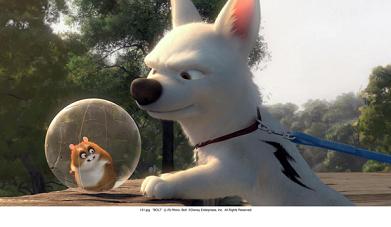
RI: Another great bonus feature is Super Rhino. Will it be theatrically screened so that it can be considered for the Best Short Oscar?
MW: Sadly, no, but hey – if millions and millions and millions of people buy the DVD, that will be the best award of all.
RI: The production of the Super Rhino short was super fast, wasn’t it?
MW: I’m told it took 3-4 months. Crazy, huh?
RI: Was it hard to do the singing part in the short? How familiar did you have to get with the collected works of Miley Cyrus to prepare for it?
MW: Well, I had to listen to that Best of Both Worlds song over and over! But as it turned out, what was funnier was Rhino singing a really bad version of the song that wasn’t quite accurate. I actually did the song several times before they got me to sing it bad enough, so I guess that was a challenge. It was fun, though!
RI: Was Miley’s recording for the short built into the studio sessions for the feature?
MW: No, the recording sessions for the movie were all separate, and recording for the short happened after the movie was mostly wrapping up. It was hard, because people were pretty wiped out from finishing the movie (some were still working on it) but they had to whip up the short in time for the DVD release! But the two were separate.

RI: Have you met Miley Cyrus and did you get her autograph?
MW: I did meet Miley Cyrus! This young woman at the studio suddenly shouted at me from down the hall, and was complimenting my performance, and I thought she was sweet – and then someone asked if we wanted a picture together, and I didn’t realize until she came up right next to me it was her! She seemed really nice. I didn’t have time to get her autograph, but I got a nice picture with her!
RI: How did she feel about Rhino doing Best of Both Worlds?
MW: Frankly, I’m afraid she was consumed by jealousy and a serious inferiority complex – I can’t blame her, it’s gotta be hard to see the writing on the wall. No, seriously, I’m not sure if she’s seen the finished film with my singing yet, but I’m sure my (purposely) bad version of the song makes her look even better by comparison.
RI: Will Super Rhino be getting his own feature length film?
MW: If I have anything to say about it: write to Disney once a day until it happens! There is the Rhino short on the DVD/Blu-ray, which is cool, but I hope there’s more! Write a letter! I need the money! Seriously, I really love performing Rhino, and it would be great to do more. Your mouth to Bob Iger’s ear! I don’t know of anything yet, but one can hope!
RI: Are you going to ‘be’ any other character in animation?
MW: Well, I sure hope so! It is a lot of fun – at least for me! Rhino was a really broad, silly, over-the-top character that got to be funny, dramatic, angry, serious, touching, and it was great having my voice attached to a well-animated, cute fuzzy character! I just think it’s a blast to come in in whatever clothes and pretend for the mic’, and get paid for it! I haven’t been asked to do anything else yet, but I really hope I get to do more voice parts – there’s a lot of talented people I have to compete with, but I can hope! I’m hoping that if people make a really big fuss about the DVD (nudge, nudge) that directors everywhere will be fighting each other to cast me in their films! If not, I always have my day job as a story artist for Disney, so that’s not too shabby either.
RI: And now, you’re also a visual development artist on King of the Elves. Could you describe your work as such?
MW: Sure – basically, I work with the director(s) figuring out the characters and the world of the story. Like, what do the characters look like? What are their personalities like? How do they relate to each other? Where does the movie take place – what country, what time of year, what are some cool places the sequences could happen in? What kinds of things could happen that would showcase the characters personalities, and be fun to watch? What is the movie really trying to say, if anything – what are the themes? These are all things that can be explored by writing, doodling, discussing, before the storyboarding begins (or while it’s happening). I love it – it’s at the stage where we can try anything and everything.
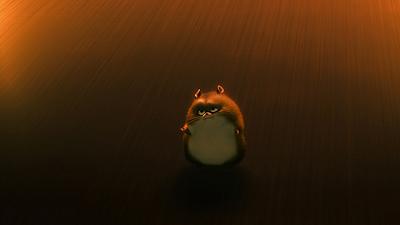
RI: As a visual development artist, how much of an influence do you have on the way a character ultimately looks like?
MW: It depends on the film and the director, and how early I’m brought onto a show. Sometimes I’ve come on really early, when a lot of decisions haven’t even been thought of yet, so there’s the potential, if I come up with some great ideas, that they might make it into the final character design. Of course, even if the directors like my ideas or the designs I do, they may end up changing the story so much, that those characters have to change, or get cut out altogether, and that’s just the way it is. Sometimes the directors are designers themselves, or they want to work with a character designer who will do things in their own distinct way – sometimes the most important thing I do is figure out what they don’t want to do, by experimenting. Either way, whether they use my ideas or not, I get paid, so it’s all good.
RI: Usually a comedic approach is used for (American) animation. Why is that and do you think another, more dramatic approach is also feasible (like in Japan, for example)?
MW: Here’s my take, for what it’s worth: I think that a lot of people in the US, as well as other countries, have the idea that animation is primarily for children, and kids like to be entertained! And animated films here tend to have crazy fantastic situations that would be difficult to do in live action, like with talking animals or monsters or whatnot, and that lends itself well to comedy, I think. It’s hard, because American film studios have taken chances on making films that are more serious and/or dramatic, but everyone here seems to turn out for the comedies, so it’s hard to justify taking that kind of risk, but if more people did, maybe American audiences would get more used to it. Just like I wish that some of my favorite Anime directors, that tell some amazing stories, won’t experiment with different styles of design, or more sophisticated animation or lip-syncing, because Japanese audiences are used to the same-ol same ol, for the most part. Maybe if audiences all over the world would check out animation from other countries, filmmakers would be more sophisticated and experimental.
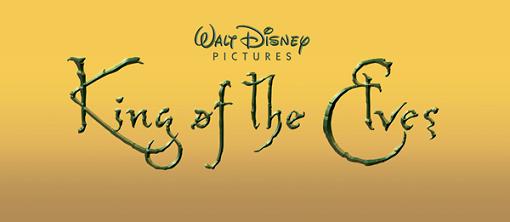
RI: Could you tell us something about the upcoming King of the Elves? Are you excited about it? And, since it is based on a Philip K. Dick-story, will it perhaps be more dramatic/philosophical in nature than previous work?
MW: King of the Elves is looking really cool right now. I really like the short story it’s based on, and I think the filmmakers want to bring a degree of realism and complexity that we haven’t seen before. I think it’ll be very dramatic and philosophical. But did you see The Iron Giant? I thought that had some really heavy, serious themes (in addition to a lot of great comedy) that were dealt with really well. There’s a lot of pretty heavy stuff in animation out there if you’re willing to look for it – check out Frederic Bach’s gorgeous films, or Waltz with Bashir, if you’re in a really good mood (it’s pretty dark!). Or maybe you already know about all this, huh?
RI: I’ve read that you once wanted to become a Muppet designer. What kind of Muppet would you have liked to design?
MW: Ooh – nobody’s asked me that before! I would have loved to make a Muppet version of this alien character I came up with as a little kid – he had one eye and big feet, kinda like Mickey Mouse’s shoes, and rubber-hosey arms and legs. My brother has actually designed, built, and performed puppets for a children’s theater in Colorado, as well as for Die Hard: the Puppet Musical in New York – it would be cool to do some puppet stuff with him sometime!
With very special thanks to Mac & Dre at Click, and to Marylin and Kevin at WDSHE.



